NCERT Class 10 Maths Chapter 3 Pair of Linear Equations in Two Variables Notes - Download PDF Notes
Turn tricky linear equations into scoring questions with these notes. Linear equations in two variables serve as key components of algebraic mathematics structures because they help solve problems which require solutions for two unknown factors. The relationship between two variables becomes established through basic mathematical operations such as addition and subtraction, as well as multiplication. Linear equations consist of a single degree value; thus, all variables possess an exponent value of 1. The equations produce straight lines which appear on coordinate planes during graphical representation. Curated by Careers360 experts, these NCERT notes strictly follow the updated syllabus, ensuring focused and effective learning.
This Story also Contains
- Class 10 Pair of Linear Equations in Two Variables Notes PDF – Download Free Study Material
- NCERT Class 10 Maths Chapter 3 Notes: Pair of Linear Equations in Two Variables
- How to Use the Linear Equations in Two Variables Class 10 Notes Effectively?
- Pair of Linear Equations in Two Variables Class 10 Notes: Previous Year Question and Answer
- NCERT Class 10 Maths Notes – Chapter-Wise Links
- NCERT Books and Syllabus
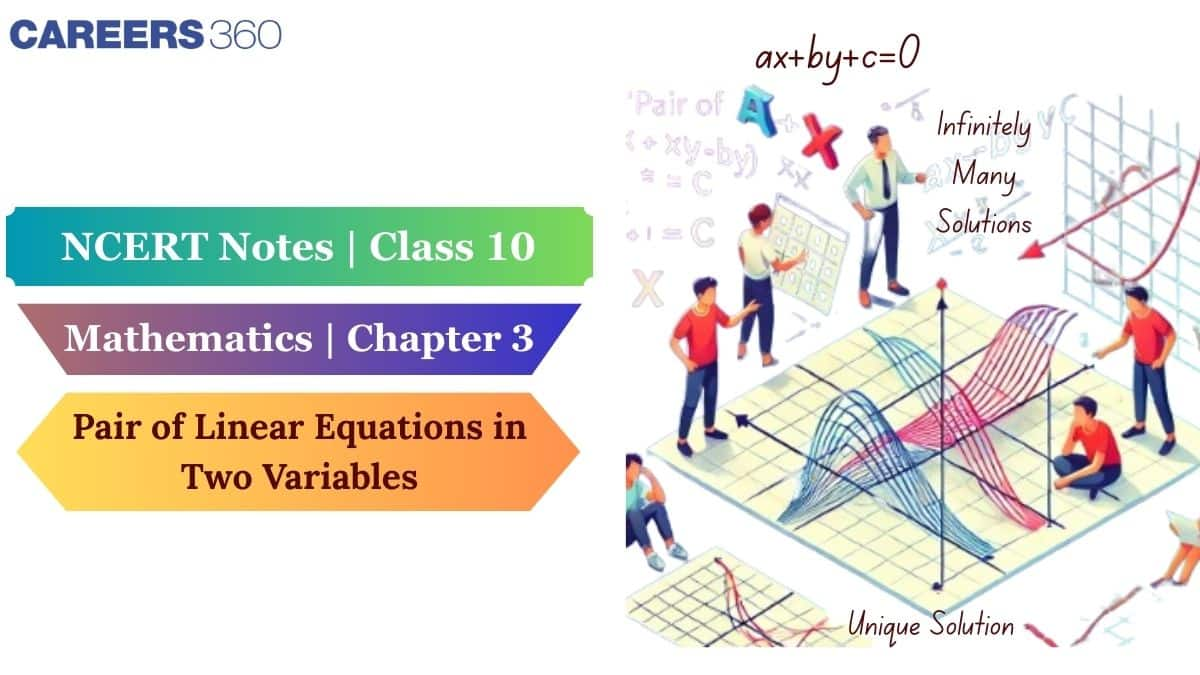
Using these NCERT Class 10 Maths Chapter 3 notes, students can clear their doubts and strengthen their concepts. Engineers from multiple backgrounds, including physics and mathematics, together with economics and computer science and mathematics make extensive use of these equations when addressing real-world problems. There are three main methods to solve these problems: graphical representation and substitution, as well as elimination, which allow students to find solutions via structured methods. These NCERT class 10th maths notes comprehensively cover all the topics, subtopics, short tricks, formulae, and other important key points. Find everything in one place – NCERT Books, Solutions, Syllabus, and Exemplar Problems with Solutions – in this NCERT article.
Also, read,
Class 10 Pair of Linear Equations in Two Variables Notes PDF – Download Free Study Material
Students who wish to access these NCERT Class 10 Maths Chapter 3 Notes can click on the link below to download the entire notes in PDF.
NCERT Class 10 Maths Chapter 3 Notes: Pair of Linear Equations in Two Variables
Careers360 brings you these NCERT Class 10 Maths Chapter 3 Pair of Linear Equations in Two Variables notes, carefully prepared by subject experts to simplify your studies and help in exams.
Equation
When two mathematical expressions and one or more variables are set equal to each other, this relationship becomes an equation.
Examples: x + 5 = 10, x² – 4x + 4 = 0, x³ – 3x² + 2x = 0
Linear Equation
Linear equations exist when all involved variables have their power set equal to one. Linear equations always maintain a degree value of 1.
The general form of a linear equation is ax + b = 0
Examples: 2x + 3 = 7, 5y – 4 = 16
General Form of a Linear Equation in Two Variables
Linear equations written in standard form appear as ax + by + c = 0, with the conditions that neither a nor b equals zero.
Examples: 2x + 3y = 6, x – 4y = 8
Convert the Word Problem into a Proper Linear Equation
Steps to convert:
- Variables should represent unidentified qualities found in the problem.
- Write mathematical expressions to show quantity relationships, then substitute unknown values with variables.
Example: A bookstore sells notebooks and pens. The total cost of 4 notebooks and 3 pens is Rs. 22. The total cost of 2 notebooks and 5 pens is Rs. 18. Write a system of linear equations to represent this situation.
Identify Variables: Need to define variables for the unknown quantities, which are cost.
- Represent the cost of one notebook (in rupees).
- Represent the cost of one pen (in rupees).
Write Mathematical Expressions: Now, we express the given relationships as equations:
- The total cost of 4 notebooks and 3 pens is Rs. 22: 4x + 3y = 22
- The total cost of 2 notebooks and 5 pens is Rs. 18: 2x + 5y = 18
Ways to Find the Solutions of Linear Equations
There are two ways to solve the linear equations, that are:
- Graphical Method
- Algebraic Method
Graphical Method
A pair of linear equations becomes solvable through the graphical method, which transforms them into straight lines on a coordinate plane. Evaluation of the lines at their intersection points determines the solutions for the given equations. To solve equations graphically:
- Plot the equations on the Cartesian Plane
- Analyse the intersection:
- The lines intersect at a single point. In this case, the pair of equations has a unique solution.
- The parallel lines. In this case, the equations have no solution.
- The coincident lines. In this case, the equations have infinitely many solutions.
Important Concepts
- A pair of linear equations which has no solution is called an inconsistent pair of linear equations.
- A pair of linear equations in two variables, which has one solution, is called a consistent pair of linear equations.
- A pair of linear equations which are equivalent has infinitely many distinct common solutions. Such a pair is called a dependent and consistent pair of linear equations in two variables.
Types of Intersection
There are three possibilities for the Intersection of a pair of straight lines on a plane:
1) Intersect at a single point
2) They are parallel
3) They are coincidental
- Intersect at a single point:
Suppose that there are two lines given as
ax + by + c = 0
dx + ey + f = 0
Then these two lines intersect only if
$\frac{a}{d}\neq\frac{b}{e}\neq\frac{c}{f}$
Example:
x + y = 1
y = x
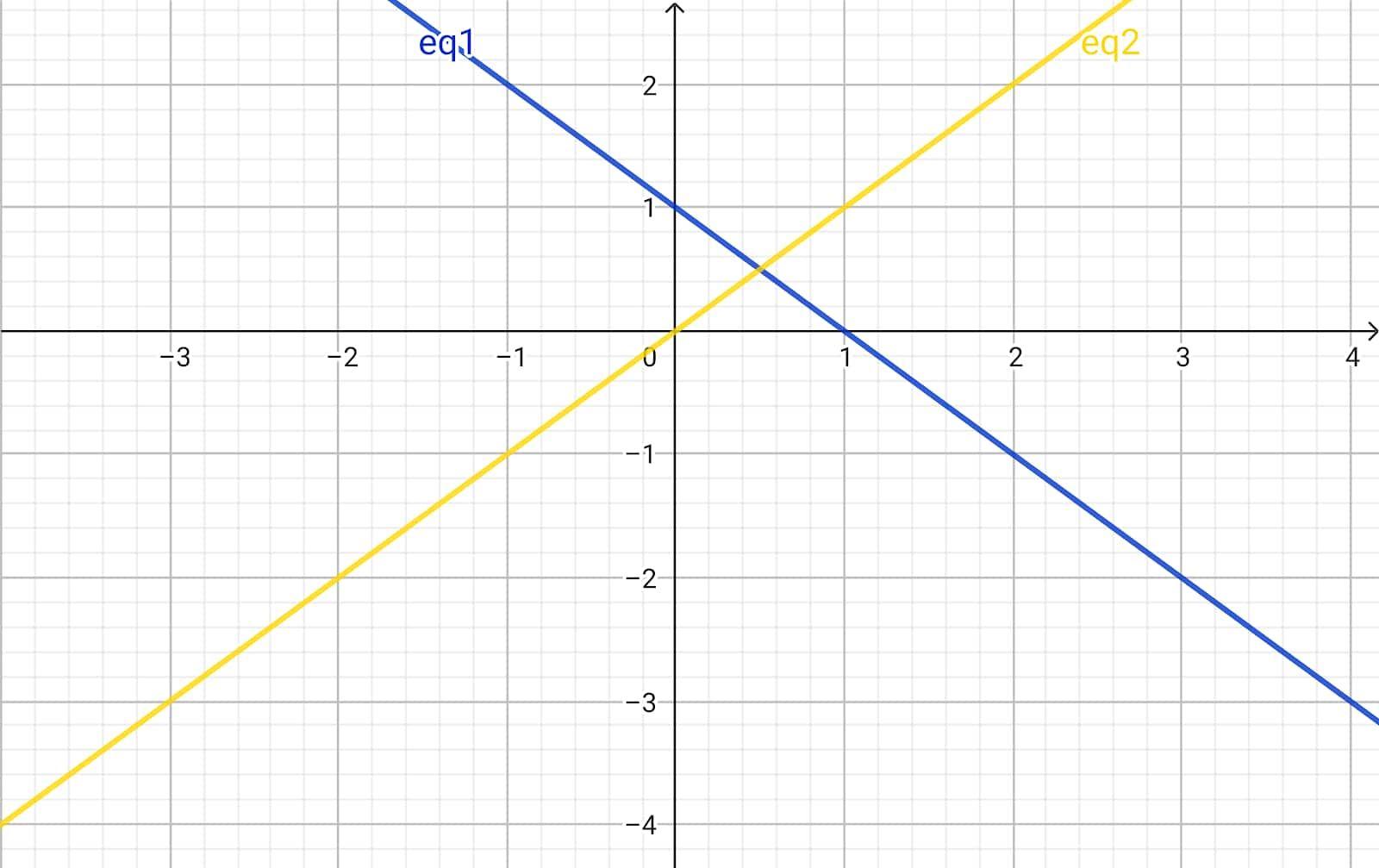
In this case, the pair of equations has a unique solution and thus is called a consistent pair of linear equations.
- They are parallel:
Suppose that there are two lines given as
ax + by + c = 0
dx + ey + f = 0
Then these two lines are parallel only if
$\frac{a}{d}\neq\frac{b}{e}=\frac{c}{f}$
Example:
x + y = 1
x + y = 2
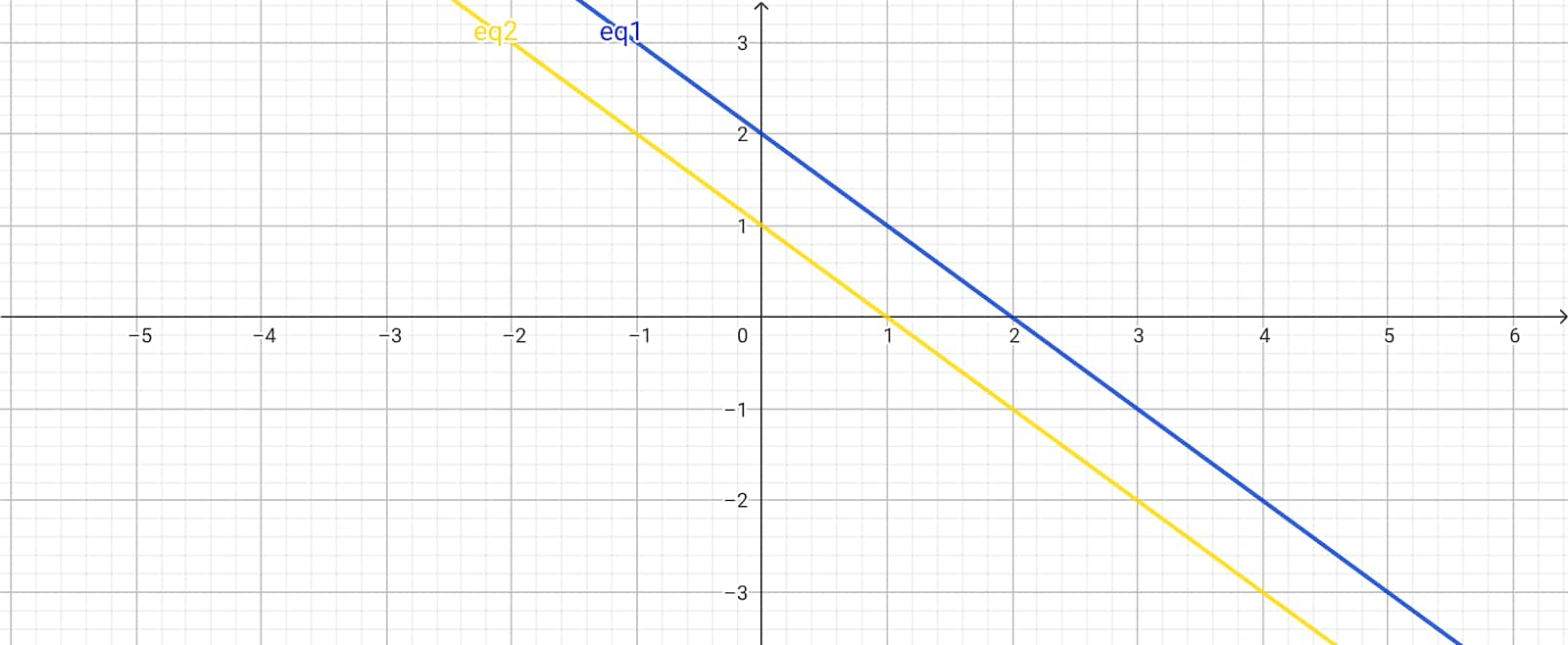
A pair of linear equations has no solution and thus is called an inconsistent pair of linear equations.
- They are coincidental:
Suppose that there are two lines given as
ax + by + c = 0
dx + ey + f = 0
Then these two lines coincide only if
$\frac{a}{d}=\frac{b}{e}=\frac{c}{f}$
Example:
x + y = 1
y + x = 1
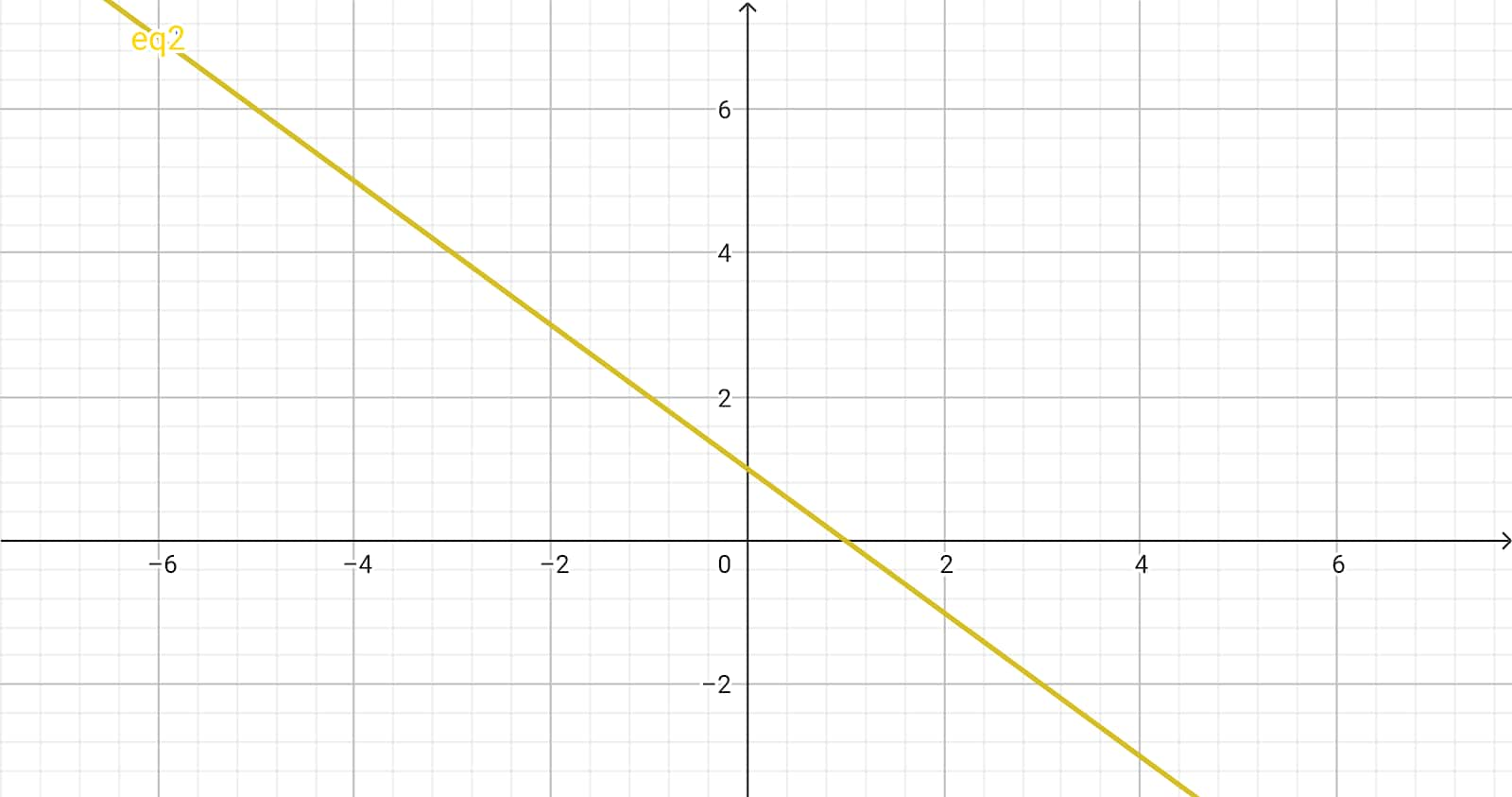
A pair of linear equations is equivalent and has infinitely many distinct common solutions, and thus such a pair is called a dependent and consistent pair of linear equations in two variables.
Tabular form
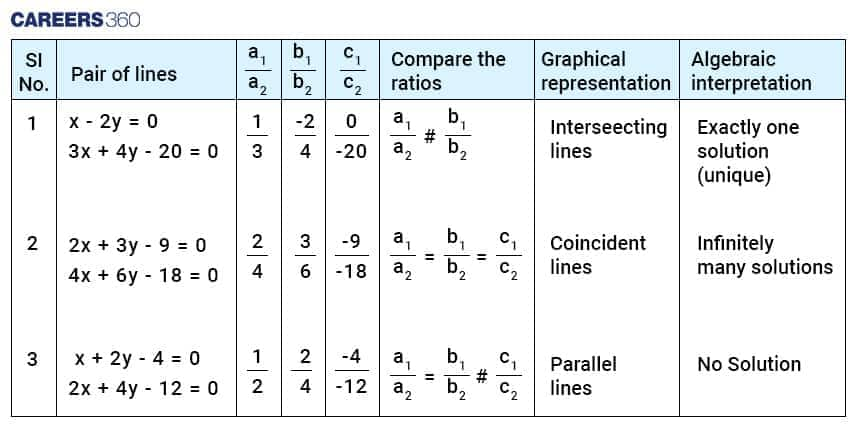
Observation:
If the lines represented by the equations $a x+b y+c=0$ and $d x+e y+f=0$ are:
(i) Intersecting, then
$\frac{a}{d} \neq \frac{b}{e}$
(ii) Parallel, then
$\frac{a}{d}=\frac{b}{e} \neq \frac{c}{f}$
(iii) Coincident, then
$\frac{a}{d}=\frac{b}{e}=\frac{c}{f}$
Problems with the Graphical Method
1. Not Always Accurate:
The task of creating perfect straight lines through graph paper proves challenging for most people. Small plotting errors or misdrawn lines make it possible to arrive at incorrect solutions.
2. Difficult for Complex Values:
The exact point of intersection is hard to determine when the solution involves fractional or decimal values (e.g. x = 2.73).
3. Takes More Time:
The process of plotting two equations, followed by line drawing, before locating the intersection takes up more time.
4. Not Practical for Large Numbers:
The process of graphing points from large numbers (such as 235x + 578y = 3467 ) effectively becomes impractical when performed on a graph.
Algebraic Method
Due to the issues of the Graphical Method, Algebraic Methods were introduced and helped to provide accurate solutions. There are two types of Algebraic methods:
- Substitution Method
- Elimination Method
Substitution Method
Substitute the value of one variable by expressing it in terms of the other variable to solve the pair of linear equations.
Steps to solve linear equations by the substitution method
- Find the value of a variable, say y, described in terms of another variable x through either available equation, whichever is convenient.
- Substitute this value of y with the variable in the second equation to make the equation in one variable, and it can be solved now.
- The result obtained from Step 2 should be used to replace x (or y) within the equation from Step 1, leading to the value of another variable.
Example:
The pair of linear equations:
7x – 15y = 2
x + 2y = 3
Solution:
Step 1: Pick either of the equations and write one variable in terms of the other.
Let us consider Equation (2):
x + 2y = 3
and write it as x = 3 – 2y
Step 2: Substitute the value of x in Equation (1) i.e. 7x – 15y = 2
7(3 – 2y) – 15y = 2
After solving the equation, get the value of y
21 – 14y – 15y = 2
⇒ – 29y = –19
⇒ y = $\frac{19}{29}$
Step 3: Substituting this value of y in the Equation we get from step 1, we get
x = 3 – 2( $\frac{19}{29}$)
⇒ x = $3-\frac{77}{29}$
⇒ x = $\frac{10}{29}$
Points to remember:
- If, while solving the equation in step 2, we end up with a true statement like 0 = 0, the equations represent the same lines or coincident lines, which means infinitely many solutions.
- If, while solving the equation in step 2, we end up with a false statement like 8 = 7, the equations represent the parallel lines, which means no solution.
Elimination Method
Eliminate one variable first to get a linear equation in one variable.
Steps to solve linear equations by the elimination method:
- Begin by multiplying each equation by appropriate non-zero constants that make the x or y coefficients match numerically.
- Then add or subtract one equation from the other so that one variable gets eliminated.
- Solve the equation by reducing it to one variable and obtain its value.
- Substitute the obtained value of x (or y) into any of the original equations to determine the value of another variable.
Example: The pair of linear equations:
9x – 4y = 2000
7x – 3y = 2000
Solution:
Step 1: To make the coefficients of one variable equal, multiply Equation (1) by 3 and Equation (2) by 4,
27x – 12y = 6000
28x – 12y = 8000
Step 2: Subtract the equations to eliminate y, because the coefficients of y are the same.
(28x – 27x) – (12y – 12y) = 8000 – 6000
Step 3: Solve the equation:
28x – 27x = 2000
x = 2000
Step 4: Substituting this value of x in given equation i.e. 9x – 4y = 2000, to get the value of y:
9(2000) – 4y = 2000
i.e., y = 4000
Points to remember:
- If in Step 2, we obtain a true statement involving no variable, then the original pair of equations has infinitely many solutions.
- If in Step 2, we obtain a false statement involving no variable, then the original pair of equations has no solution, i.e., it is inconsistent.
How to Use the Linear Equations in Two Variables Class 10 Notes Effectively?
Linear Equations in Two Variables become easier when we understand how two lines can meet, be parallel, or overlap. This chapter teaches us both graph and algebra methods to solve a pair of equations. When we revise these slowly, the steps become clear. Class 10 Maths chapter 3 notes help us a lot with this. Here are some more points on how these notes are important.
- Read the basics and try a few graph-based questions to understand how the point of intersection shows the solution.
- Practise the substitution and elimination methods thoroughly, so we know which method to use during exercises or exams.
- Keep the NCERT Class 10 Maths chapter 3 notes open while solving sums to check each step and correct small mistakes.
- Use the NCERT Class 10 Maths chapter 3 notes effectively, because these solving methods are used again in higher classes and in algebra chapters later on.
Pair of Linear Equations in Two Variables Class 10 Notes: Previous Year Question and Answer
Given below are selected previous year question answers for NCERT Class 10 Maths Chapter 3 Pair of Linear Equations in Two Variables, collected from various examinations.
Question 1:
Student A got 25 marks more than student B, and the marks of A were equal to 60% of the sum of their marks. What are the marks obtained by A and B, respectively?
Solution:
Let the marks of student A as p and the marks of student B as q.
From the problem, we have two equations:
Since A got 25 marks more than B
⇒ p = q + 25 ...(1)
Since the marks of A were equal to 60% of the sum of their marks
⇒ p = 0.6 × (p + q) ...(2)
Substituting equation 1 into equation 2, we get:
⇒ q + 25 = 0.6 × (q + 25 + q)
⇒ q + 25 = 1.2q + 15
⇒ 0.2q = 10
⇒ q = 50
$\therefore$ p = 50 + 25 = 75
Hence, the correct answer is 75 and 50.
Question 2:
Kushal has some hens and some goats. If the total number of animal heads is 100 and the total number of animal feet is 348, then what is the total number of goats with Kushal?
Solution:
As per fact, hens and goats each have one head, 2 legs, and 4 legs respectively.
Let the number of hens be $x$.
⇒ Number of goats is $y$.
According to the question,
$x + y = 100$---(1) [Total heads = 100]
Also $2x + 4y = 348$---(2) [total feets = 348]
⇒ $x+2y=174$
From equation 1, we can write,
⇒ $100-y+2y=174$
⇒ $y = 74$
Hence, the correct answer is 74.
Question 3:
For what value of m will the system of equations $17x + my + 102 = 0$ and $23x + 299y + 138 = 0$ have an infinite number of solutions?
Solution:
Given: $17x + my + 102 = 0$ and $23x + 299y + 138 = 0$
$a_1x + b_1y + c_1 = 0$
$a_2x + b_2y + c_2 = 0$
The condition for an infinite number of solutions is $\frac{a_1}{a_2}=\frac{b_1}{b_2}=\frac{c_1}{c_2}$
According to the question,
$\frac{17}{23}=\frac{m}{299}$
⇒ $m=\frac{17×299}{23}$
⇒ $m= 17 × 13$
⇒ $m= 221$
Hence, the correct answer is 221.
NCERT Class 10 Maths Notes – Chapter-Wise Links
For students' preparation, Careers360 has gathered all Class 10 Maths NCERT Notes here for quick and convenient access.
|
NCERT Notes Class 10 Maths Chapter 3 Linear Equations in Two Variables |
|
NCERT Notes Class 10 Maths Chapter 8 Introduction to Trigonometry |
|
NCERT Notes Class 10 Maths Chapter 9 Some Applications of Trigonometry |
|
NCERT Notes Class 10 Maths Chapter 11 Area Related to Circles |
|
NCERT Notes Class 10 Maths Chapter 12 Surface Area and Volumes |
NCERT Exemplar Solutions for Class 10
Students must check the NCERT Exemplar solutions for class 10 of Mathematics and Science Subjects.
NCERT Solutions for Class 10
Students must check the NCERT solutions for class 10 of Mathematics and Science Subjects.
NCERT Books and Syllabus
To learn about the NCERT books and syllabus, read the following articles and get a direct link to download them.
Frequently Asked Questions (FAQs)
Equations of the form ax + by + c = 0, where x and y are variables a, b and c are constants, are represented as a linear equation in two variables.
There are three methods to solve linear equations:
(1) Graphical Method
(2) Substitution Method
(3) Elimination Method
Linear equations written in standard form appear as ax + by + c = 0, with the conditions that a and b are variables and x,y and c are constants and neither of them is equal to zero.
Examples: 2x + 3y = 6, x – 4y = 8
To represent a linear equation graphically:
- Convert the equation to the form y=mx+c.
- Find at least two points by substituting values for x and y calculating.
- Plot the points on a Cartesian plane.
- Draw a straight line passing through the points.
- The lines intersect at a single point. In this case, the pair of equations has a unique solution.
- The parallel lines. In this case, the equations have no solution.
- The coincident lines. In this case, the equations have infinitely many solutions.
1) A pair of linear equations which has no solution is called an inconsistent pair of linear equations.
2) A pair of linear equations in two variables, which has one solution, is called a consistent pair of linear equations.
3) A pair of linear equations which are equivalent has infinitely many distinct common solutions.
4) Such a pair is called a dependent and consistent pair of linear equations in two variables.
Courses After 12th
Applications for Admissions are open.
As per latest syllabus. Physics formulas, equations, & laws of class 11 & 12th chapters
JEE Main Important Chemistry formulas
Get nowAs per latest syllabus. Chemistry formulas, equations, & laws of class 11 & 12th chapters
JEE Main high scoring chapters and topics
Get nowAs per latest 2024 syllabus. Study 40% syllabus and score upto 100% marks in JEE
JEE Main Important Mathematics Formulas
Get nowAs per latest syllabus. Maths formulas, equations, & theorems of class 11 & 12th chapters
